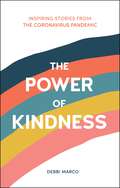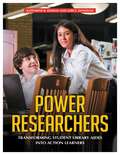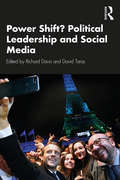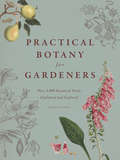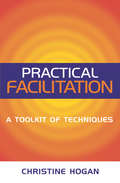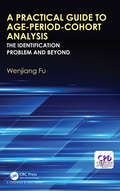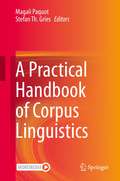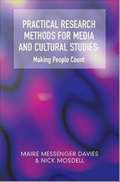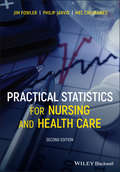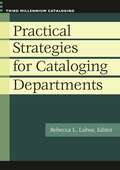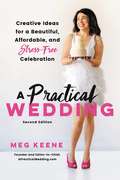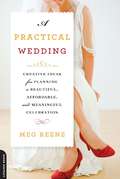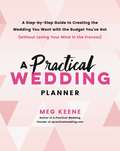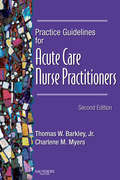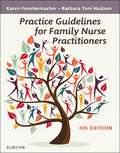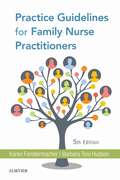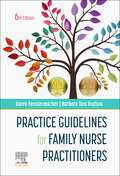- Table View
- List View
The Power of Kindness: Inspiring Stories, Heart-Warming Tales and Random Acts of Kindness from the Coronavirus Pandemic
by Debbi MarcoKindness mattersWhen times are hard, we pull together. Despite the difficulties of life during the coronavirus pandemic, love and kindness prevail.Dive into this heart-warming book and discover the many uplifting and inspiring acts of kindness that have come from the crisis. Read about the postman who donned fancy dress while doing his rounds to bring a smile to his community, the mum who set up a virtual story time for young children, or the schools that worked together to manufacture face masks for local care homes and hospitals.The coronavirus crisis may be a challenging time for the world, but the amazing stories in this book show that nobody is too small to make a difference – and that, no matter what, we can always find light in the darkness.
The Power of Opposition: How Legislative Organization Influences Democratic Consolidation (Routledge Research in Comparative Politics)
by Simone WegmannProposing a novel way to look at the consolidation of democratic regimes, this book presents important theoretical and empirical contributions to the study of democratic consolidation, legislative organization, and public opinion. Theoretically, Simone Wegmann brings legislatures into focus as the main body representing both winners and losers of democratic elections. Empirically, Wegmann shows that the degree of policy-making power of opposition players varies considerably between countries. Using survey data from the CSES, the ESS, and the LAPOP and systematically analyzing more than 50 legislatures across the world and the specific rights they grant to opposition players during the policy-making process, Wegmann demonstrates that neglecting the curial role of the legislature in a democratic setting can only lead to an incomplete assessment of the importance of institutions for democratic consolidation. The Power of Opposition will be of great interest to scholars of comparative politics, especially those working on questions related to legislative organization, democratic consolidation, and/or public opinion.
The Power of Opposition: How Legislative Organization Influences Democratic Consolidation (Routledge Research in Comparative Politics)
by Simone WegmannProposing a novel way to look at the consolidation of democratic regimes, this book presents important theoretical and empirical contributions to the study of democratic consolidation, legislative organization, and public opinion. Theoretically, Simone Wegmann brings legislatures into focus as the main body representing both winners and losers of democratic elections. Empirically, Wegmann shows that the degree of policy-making power of opposition players varies considerably between countries. Using survey data from the CSES, the ESS, and the LAPOP and systematically analyzing more than 50 legislatures across the world and the specific rights they grant to opposition players during the policy-making process, Wegmann demonstrates that neglecting the curial role of the legislature in a democratic setting can only lead to an incomplete assessment of the importance of institutions for democratic consolidation. The Power of Opposition will be of great interest to scholars of comparative politics, especially those working on questions related to legislative organization, democratic consolidation, and/or public opinion.
Power Researchers: Transforming Student Library Aides into Action Learners
by Lori E. Donovan Katherine B. LehmanThis book presents a proven year-long program to boost student productivity and train high school library aides while offering services to all patrons of the school library. Power Researchers: Transforming Student Library Aides Into Action Learners is a unique practical guide for high school librarians to use in developing a curriculum for student library aides that expands their knowledge, develops literature appreciation, and models 21st-century teaching skills. Authors Lehman and Donovan—both experienced high school librarians—explain how to get maximum results from their proven "learn by doing and helping others" philosophy and techniques, increasing productivity in your library and giving students the necessary information literacy skills for success.This book is filled with reproducible lesson plans, student worksheets, and rubrics. Lessons incorporate specific skills, dispositions, responsibilities, and self-assessment strategies from the AASL Standards for 21st Century Learners. The lessons and reproducibles are not just limited to use with library aides; these materials can also be utilized in collaboration with classroom teachers for whole class instruction in all content areas. Useful links to many online lessons, modules, and Web 2.0 tools are also included.
Power Shift? Political Leadership and Social Media: Case Studies in Political Communication
by Richard Davis; David TarasPower Shift? Political Leadership and Social Media examines how political leaders have adapted to the challenges of social media, including Facebook, Instagram, Twitter, and memes, among other means of persuasion. Established political leaders now use social media to grab headlines, respond to opponents, fundraise, contact voters directly, and organize their election campaigns. Leaders of protest movements have used social media to organize and galvanize grassroots support and to popularize new narratives: narratives that challenge and sometimes overturn conventional thinking. Yet each social media platform provides different affordances and different attributes, and each is used differently by political leaders. In this book, leading international experts provide an unprecedented look at the role of social media in leadership today. Through a series of case studies dealing with topics ranging from Emmanuel Macron and Donald Trump's use of Twitter, to Justin Trudeau's use of selfies and Instagram, to how feminist leaders mobilize against stereotypes and injustices, the authors argue that many leaders have found additional avenues to communicate with the public and use power. This raises the question of whether this is causing a power shift in the relationship between leaders and followers. Together the chapters in this book suggest new rules of engagement that leaders ignore at their peril. The lack of systematic theoretically informed and empirically supported analyses makes Power Shift? Political Leadership and Social Media an indispensable read for students and scholars wishing to gain new understanding on what social media means for leadership.
Power Shift? Political Leadership and Social Media: Case Studies in Political Communication
by David Taras Richard DavisPower Shift? Political Leadership and Social Media examines how political leaders have adapted to the challenges of social media, including Facebook, Instagram, Twitter, and memes, among other means of persuasion. Established political leaders now use social media to grab headlines, respond to opponents, fundraise, contact voters directly, and organize their election campaigns. Leaders of protest movements have used social media to organize and galvanize grassroots support and to popularize new narratives: narratives that challenge and sometimes overturn conventional thinking. Yet each social media platform provides different affordances and different attributes, and each is used differently by political leaders. In this book, leading international experts provide an unprecedented look at the role of social media in leadership today. Through a series of case studies dealing with topics ranging from Emmanuel Macron and Donald Trump's use of Twitter, to Justin Trudeau's use of selfies and Instagram, to how feminist leaders mobilize against stereotypes and injustices, the authors argue that many leaders have found additional avenues to communicate with the public and use power. This raises the question of whether this is causing a power shift in the relationship between leaders and followers. Together the chapters in this book suggest new rules of engagement that leaders ignore at their peril. The lack of systematic theoretically informed and empirically supported analyses makes Power Shift? Political Leadership and Social Media an indispensable read for students and scholars wishing to gain new understanding on what social media means for leadership.
Practical Botany for Gardeners: Over 3,000 Botanical Terms Explained and Explored
by Geoff HodgeGardening can be frustratingly shrouded in secrecy. Fickle plants make seemingly spontaneous decisions to bloom or bust, seeds sprout magically in the blink of an eye, and deep-rooted mysteries unfold underground and out of sight. Understanding basic botany is like unlocking a horticultural code; fortunately learning a little science can reveal the secrets of the botanical universe and shed some light on what’s really going on in your garden. Practical Botany for Gardeners provides an elegant and accessible introduction to the world of botany. It presents the essentials that every gardener needs to know, connecting explanations of scientific facts with useful gardening tips. Flip to the roots section and you’ll not only learn how different types of roots support a plant but also find that adding fungi to soil aids growth. The pruning section both defines “lateral buds” and explains how far back on a shoot to cut in order to propagate them. The book breaks down key areas and terminology with easy-to-navigate chapters arranged by theme, such as plant types, plant parts, inner workings, and external factors. “Great Botanists” and “Botany in Action” boxes delve deeper into the fascinating byways of plant science. This multifaceted book also includes two hundred botanical illustrations and basic diagrams that hearken to the classic roots of botany. Part handbook, part reference, Practical Botany for Gardeners is a beautifully captivating read. It’s a must for garden lovers and backyard botanists who want to grow and nurture their own plant knowledge.
Practical Botany for Gardeners: Over 3,000 Botanical Terms Explained and Explored
by Geoff HodgeGardening can be frustratingly shrouded in secrecy. Fickle plants make seemingly spontaneous decisions to bloom or bust, seeds sprout magically in the blink of an eye, and deep-rooted mysteries unfold underground and out of sight. Understanding basic botany is like unlocking a horticultural code; fortunately learning a little science can reveal the secrets of the botanical universe and shed some light on what’s really going on in your garden. Practical Botany for Gardeners provides an elegant and accessible introduction to the world of botany. It presents the essentials that every gardener needs to know, connecting explanations of scientific facts with useful gardening tips. Flip to the roots section and you’ll not only learn how different types of roots support a plant but also find that adding fungi to soil aids growth. The pruning section both defines “lateral buds” and explains how far back on a shoot to cut in order to propagate them. The book breaks down key areas and terminology with easy-to-navigate chapters arranged by theme, such as plant types, plant parts, inner workings, and external factors. “Great Botanists” and “Botany in Action” boxes delve deeper into the fascinating byways of plant science. This multifaceted book also includes two hundred botanical illustrations and basic diagrams that hearken to the classic roots of botany. Part handbook, part reference, Practical Botany for Gardeners is a beautifully captivating read. It’s a must for garden lovers and backyard botanists who want to grow and nurture their own plant knowledge.
Practical Facilitation: A Toolkit of Techniques
by Christine HoganA facilitator helps groups of people to enable them to interact more effectively in a wide range of situations and occupations, including workplaces, organizational planning, leisure and health activities and community development. Facilitation is an emerging and exciting profession.
A Practical Guide to Age-Period-Cohort Analysis: The Identification Problem and Beyond
by Wenjiang FuAge-Period-Cohort analysis has a wide range of applications, from chronic disease incidence and mortality data in public health and epidemiology, to many social events (birth, death, marriage, etc) in social sciences and demography, and most recently investment, healthcare and pension contribution in economics and finance. Although APC analysis has been studied for the past 40 years and a lot of methods have been developed, the identification problem has been a major hurdle in analyzing APC data, where the regression model has multiple estimators, leading to indetermination of parameters and temporal trends. A Practical Guide to Age-Period Cohort Analysis: The Identification Problem and Beyond provides practitioners a guide to using APC models as well as offers graduate students and researchers an overview of the current methods for APC analysis while clarifying the confusion of the identification problem by explaining why some methods address the problem well while others do not. Features · Gives a comprehensive and in-depth review of models and methods in APC analysis. · Provides an in-depth explanation of the identification problem and statistical approaches to addressing the problem and clarifying the confusion. · Utilizes real data sets to illustrate different data issues that have not been addressed in the literature, including unequal intervals in age and period groups, etc. Contains step-by-step modeling instruction and R programs to demonstrate how to conduct APC analysis and how to conduct prediction for the future Reflects the most recent development in APC modeling and analysis including the intrinsic estimator Wenjiang Fu is a professor of statistics at the University of Houston. Professor Fu’s research interests include modeling big data, applied statistics research in health and human genome studies, and analysis of complex economic and social science data.
A Practical Guide to Age-Period-Cohort Analysis: The Identification Problem and Beyond
by Wenjiang FuAge-Period-Cohort analysis has a wide range of applications, from chronic disease incidence and mortality data in public health and epidemiology, to many social events (birth, death, marriage, etc) in social sciences and demography, and most recently investment, healthcare and pension contribution in economics and finance. Although APC analysis has been studied for the past 40 years and a lot of methods have been developed, the identification problem has been a major hurdle in analyzing APC data, where the regression model has multiple estimators, leading to indetermination of parameters and temporal trends. A Practical Guide to Age-Period Cohort Analysis: The Identification Problem and Beyond provides practitioners a guide to using APC models as well as offers graduate students and researchers an overview of the current methods for APC analysis while clarifying the confusion of the identification problem by explaining why some methods address the problem well while others do not. Features · Gives a comprehensive and in-depth review of models and methods in APC analysis. · Provides an in-depth explanation of the identification problem and statistical approaches to addressing the problem and clarifying the confusion. · Utilizes real data sets to illustrate different data issues that have not been addressed in the literature, including unequal intervals in age and period groups, etc. Contains step-by-step modeling instruction and R programs to demonstrate how to conduct APC analysis and how to conduct prediction for the future Reflects the most recent development in APC modeling and analysis including the intrinsic estimator Wenjiang Fu is a professor of statistics at the University of Houston. Professor Fu’s research interests include modeling big data, applied statistics research in health and human genome studies, and analysis of complex economic and social science data.
A Practical Handbook of Corpus Linguistics
by Magali Paquot Stefan Th. GriesThis handbook is a comprehensive practical resource on corpus linguistics. It features a range of basic and advanced approaches, methods and techniques in corpus linguistics, from corpus compilation principles to quantitative data analyses. The Handbook is organized in six Parts. Parts I to III feature chapters that discuss key issues and the know-how related to various topics around corpus design, methods and corpus types. Parts IV-V aim to offer a user-friendly introduction to the quantitative analysis of corpus data: for each statistical technique discussed, chapters provide a practical guide with R and come with supplementary online material. Part VI focuses on how to write a corpus linguistic paper and how to meta-analyze corpus linguistic research. The volume can serve as a course book as well as for individual study. It will be an essential reading for students of corpus linguistics as well as experienced researchers who want to expand their knowledge of the field.
Practical Research Methods for Media and Cultural Studies: Making People Count (PDF)
by Máire Davies Nick MosdellMany very intelligent people don't like dealing with numbers. Similarly, many gifted scientists are not especially interested in studying people and their cultural behaviour. In this book, we argue that being interested in people and their cultures, and helping students and others to use numbers to pursue these interests, are not mutually exclusive. Research methods are becoming an increasingly important requirement for students of all kinds. But many students, particularly those in the humanities, struggle with concepts drawn from the social sciences and find quantitative and statistical information inaccessible and daunting. Nonetheless, such concepts are found in nearly all areas of society, from market research and opinion polls to psychological studies of human behaviour. This book aims to provide a simple guide to the process of conducting research in the humanities, with special reference to media and culture, from the planning stage, through the data gathering, to the analysis and interpretation of results: 'planning it', 'doing it' and 'understanding it'. The book aims to show how students' own choice of research topic can be refined into a manageable research question and how the most appropriate methodologies can be applied. Each section draws on actual examples from research that the authors and their students have conducted. Topics covered include: choosing a research question and method; instrument design and pilot data; practical procedures; research with children; looking at statistics; and interpretation of results. Features: *Based on the authors' practical experience as researchers and teachers and is thus accessible, practical and 'how to'. *Includes students' own work as examples. *Bridges the 'divide' between social science and humanities research methods and will therefore appeal to a broad range of students and teachers.
Practical Statistics for Nursing and Health Care
by Jim Fowler Philip Jarvis Mel ChevannesNow in its second edition, Practical Statistics for Nursing and Health Care provides a sound foundation for nursing, midwifery and other health care students and early career professionals, guiding readers through the often daunting subject of statistics ‘from scratch’. Making no assumptions about one’s existing knowledge, the text develops in complexity as the material and concepts become more familiar, allowing readers to build the confidence and skills to apply various formula and techniques to their own data. The authors explain common methods of interpreting data sets and explore basic statistical principles that enable nurses and health care professionals to decide on suitable treatment, as well as equipping readers with the tools to critically appraise clinical trials and epidemiology journals. Offers information on statistics presented in a clear, straightforward manner Covers all basic statistical concepts and tests, and includes worked examples, case studies, and data sets Provides an understanding of how data collected can be processed for the patients’ benefit Contains a new section on how to calculate and use percentiles Written for students, qualified nurses and other healthcare professionals, Practical Statistics for Nursing and Health Care is a hands-on guide to gaining rapid proficiency in statistics.
Practical Statistics for Nursing and Health Care
by Jim Fowler Philip Jarvis Mel ChevannesNow in its second edition, Practical Statistics for Nursing and Health Care provides a sound foundation for nursing, midwifery and other health care students and early career professionals, guiding readers through the often daunting subject of statistics ‘from scratch’. Making no assumptions about one’s existing knowledge, the text develops in complexity as the material and concepts become more familiar, allowing readers to build the confidence and skills to apply various formula and techniques to their own data. The authors explain common methods of interpreting data sets and explore basic statistical principles that enable nurses and health care professionals to decide on suitable treatment, as well as equipping readers with the tools to critically appraise clinical trials and epidemiology journals. Offers information on statistics presented in a clear, straightforward manner Covers all basic statistical concepts and tests, and includes worked examples, case studies, and data sets Provides an understanding of how data collected can be processed for the patients’ benefit Contains a new section on how to calculate and use percentiles Written for students, qualified nurses and other healthcare professionals, Practical Statistics for Nursing and Health Care is a hands-on guide to gaining rapid proficiency in statistics.
Practical Strategies for Cataloging Departments (Third Millennium Cataloging)
by Rebecca L. LubasCataloging managers will find this book a valuable road map for navigating the metadata needs of the 21st-century library.Demand for instant access, 24/7. Outsourcing issues. Constantly evolving standards. How can catalogers create a flexible, Web 2.0-compliant, flexible, multi-metalingual cataloging department? A daunting challenge, definitely; but with the right guidance, any cataloger can get up to speed and handle these common and confusing problems. Each chapter of Practical Strategies for Cataloging Departments is authored or coauthored by a leader in cataloging, metadata practice, or education in these specialties. This book offers practical advice—based on direct experience—for facing the challenges of organizing information today. Topics include training, collaborating across the library, coping with changes in standards, making strategic selections of vendor cataloging products, developing cooperative organizations, and more. The specific techniques that will help catalogers meet the needs of 21st century patrons are emphasized.
A Practical Wedding: Creative Ideas for a Beautiful, Affordable, and Stress-free Celebration
by Meg KeeneA companion to the popular website APracticalWedding.com and A Practical Wedding Planner, A Practical Wedding helps you sort through the basics to create the wedding you want -- without going broke or crazy in the process. After all, what really matters on your wedding day is not so much how it looked as how it felt. In this refreshing guide, expert Meg Keene shares her secrets to planning a beautiful celebration that reflects your taste and your relationship. You'll discover: The real purpose of engagement (hint: it's not just about the planning) How to pinpoint what matters most to you and your partner DIY-ing your wedding: brilliant or crazy? How to communicate decisions to your familyWhy that color-coded spreadsheet is actually worth itWedding Zen can be yours. Meg walks you through everything from choosing a venue to writing vows, complete with stories and advice from women who have been in the trenches: the Team Practical brides. So here's to the joyful wedding, the sensible wedding, the unbelievably fun wedding! A Practical Wedding is your complete guide to getting married with grace.
A Practical Wedding: Creative Ideas for Planning a Beautiful, Affordable, and Meaningful Celebration
by Meg KeeneAn Insanity-Free Wedding: It Can Happen!Getting engaged is exhilarating...until it sets in that a wedding costs three times what you thought, and takes five to ten times the effort it reasonably should. And then there are the expectations: from calligraphy invitations to satin chair-covers, all those things that Must Be Done or everyone will be Horribly Offended. Or will they?A Practical Wedding helps you create the wedding you want-without going broke or crazy in the process. After all, what really matters on your wedding day, what you'll remember 'til you're old and gray, is not so much how it looked as how it felt. In this refreshing guide, expert Meg Keene shares her secrets to planning a beautiful celebration that reflects your taste and your relationship. You'll discover:The real purpose of engagement (hint: it's not just about the planning)How to pinpoint what matters most to you and your partnerDIY-ing your wedding: brilliant or crazy?Affording a wedding without having to cut your guest listHow to communicate decisions with your familyWhy that color-coded spreadsheet is actually worth itWedding Zen can be yours. Meg walks you through everything from choosing a venue to writing vows, complete with stories and advice from women who have been in the trenches, the Team Practical brides. So here's to the joyful wedding, the sensible wedding, the unbelievably fun wedding! A Practical Wedding is your complete guide to getting married with grace.
A Practical Wedding: Creative Ideas for a Beautiful, Affordable, and Stress-free Celebration
by Meg KeeneA companion to the popular website APracticalWedding.com and A Practical Wedding Planner, A Practical Wedding helps you sort through the basics to create the wedding you want -- without going broke or crazy in the process. After all, what really matters on your wedding day is not so much how it looked as how it felt. In this refreshing guide, expert Meg Keene shares her secrets to planning a beautiful celebration that reflects your taste and your relationship. You'll discover:The real purpose of engagement (hint: it's not just about the planning) How to pinpoint what matters most to you and your partner DIY-ing your wedding: brilliant or crazy? How to communicate decisions to your familyWhy that color-coded spreadsheet is actually worth itWedding Zen can be yours. Meg walks you through everything from choosing a venue to writing vows, complete with stories and advice from women who have been in the trenches: the Team Practical brides. So here's to the joyful wedding, the sensible wedding, the unbelievably fun wedding! A Practical Wedding is your complete guide to getting married with grace.
A Practical Wedding Planner: A Step-by-Step Guide to Creating the Wedding You Want with the Budget You've Got (without Losing Your Mind in the Process)
by Meg KeeneThe author of A Practical Wedding offers a no-nonsense wedding planner, with all the tools, tips, and strategies to get the celebration you want, on a budget you can actually affordWhether you're newly engaged or haven't quite made anything official yet, but you know you want to spend your lives together, you're going to need help planning your wedding. When you're ready to take a deep breath and start, this is the book you want--need--to have. From figuring out what you really want--as opposed to what everyone else thinks you should want--to helping you keep an eye on the ceremony itself and the vows, Meg Keene, founder of apracticalwedding.com, covers all the essentials. With checklists (such as flowers, food, final venue walk-through) and key spreadsheets (guest list and seating chart, budget, venue search, and more), A Practical Wedding Planner helps you:Set a budget--and stick to itChoose a venue: traditional, non-traditional, and everything in betweenHire good vendors and keep your friendors (and tells you why DIY doesn't always save money)Figure out catering, rentals, and everything else Pinterest forgot to tell youReality-check wedding décorCreate and write a ceremony that really represents both of youGet everyone to show up...and have a good time
A Practical Wedding Planner: A Step-by-Step Guide to Creating the Wedding You Want with the Budget You've Got (without Losing Your Mind in the Process)
by Meg KeeneThe author of A Practical Wedding offers a no-nonsense wedding planner, with all the tools, tips, and strategies to get the celebration you want, on a budget you can actually afford Whether you're newly engaged or haven't quite made anything official yet, but you know you want to spend your lives together, you're going to need help planning your wedding. When you're ready to take a deep breath and start, this is the book you want--need--to have. From figuring out what you really want--as opposed to what everyone else thinks you should want--to helping you keep an eye on the ceremony itself and the vows, Meg Keene, founder of apracticalwedding.com, covers all the essentials. With checklists (such as flowers, food, final venue walk-through) and key spreadsheets (guest list and seating chart, budget, venue search, and more), A Practical Wedding Planner helps you:Set a budget--and stick to itChoose a venue: traditional, non-traditional, and everything in betweenHire good vendors and keep your friendors (and tells you why DIY doesn't always save money)Figure out catering, rentals, and everything else Pinterest forgot to tell youReality-check wedding dérCreate and write a ceremony that really represents both of youGet everyone to show up...and have a good time
Practice Guidelines for Acute Care Nurse Practitioners - E-Book
by Thomas W. Barkley Jr. Charlene M. MyersPRACTICE GUIDELINES FOR ACUTE CARE NURSE PRACTITIONERS, 2nd Edition is the only comprehensive clinical reference tailored to the needs of advance practice nurses. With discussions of more than 230 of the most common conditions experienced by adult patients in acute care, this reference includes everything you need on a day-to-day basis. Plus, quick reference is easy with a spiral binding and content organized by body system. Each condition lists a concise outline of defining terms, incidence/predisposing factors, subject and physical examination findings, diagnostic tests, and management strategies so you can find everything you need to know quickly. Includes discussion of body systems, nutritional considerations, fluid/electrolyte imbalances, shock, trauma, gerontological concerns, professional issues, and trends in advanced practice.Nursing guidelines for more than 230 of the most common conditions experienced by adult patients in acute care serve as an invaluable resource in the field.Conditions are organized by body system for quick reference when treating patients.Each condition lists defining terms, incidence/predisposing factors, subjective and physical examination findings, diagnostic tests, and management strategies to provide help every step of the way.Coverage also includes discussion of body systems, nutritional considerations, fluid/electrolyte imbalances, shock, and trauma for a complete look at patient care and diagnosis.An entire chapter dedicated to congestive heart failure gives you a deeper look at the disease.Specific content, as well as online references, for diseases such as SARS and West Nile Virus give you the most current information available on these evolving diseases.New chapters on admission, pre-op and post-op orders prepare you for every step of the patient treatment process.Addition of ICD-9 codes within the chapters makes classifying diseases with ICD codes easy.New content on Parkinson's disease, gout, testicular cancer, multiple sclerosis, bite management (including spider, snake, animal, and human) better prepare you for these situations.Updated and expanded content reflects changes in current guidelines and evidence-based practice, an important part of working in the field.Updated and expanded content on coronary artery disease and inclusion of the new JNC 7 national hypertension guidelines features more information on these common diseases.Expanded and updated coverage of postmenopausal women and hormone replacement therapy.
Practice Guidelines for Family Nurse Practitioners - E-Book: Revised Reprint
by Karen Fenstermacher Barbara Toni HudsonPrepare for FNP practice with the latest evidence-based guidelines! Practice Guidelines for Family Nurse Practitioners, 4th Edition provides essential information on current assessment and management protocols for primary care patients of all ages. Key details are easy to find, with the book’s concise, outline-style guidelines and abundant summary tables and charts. And you’ll be ready to manage care more effectively with the latest information on topics such as pain management, bariatric surgery follow-up, restless legs syndrome, and new medications for diabetes and cardiovascular disorders. Written by expert nurse practitioners Karen Fenstermacher and Barbara Toni Hudson, this guide equips you for the conditions most commonly seen in primary care settings. Essential, evidence-based guidelines provide the latest guidance for management of disorders commonly seen by FNPs in primary care settings, including information on which problems must be referred to a physician and which constitute an emergency.Quick-reference tables and charts include pediatric conditions charts, comparative charts for similar disorders, and health maintenance guidelines charts.Coverage of special populations assessment provides quick access to information on adult, pediatric, and geriatric assessment.Compact size and spiral binding make this guide easy to carry and easy to use in the clinical setting.Full-color insert provides an illustrated, quick reference to common skin disorders.Concise outline format makes it easy to locate essential information quickly. NEW! Treatment guidelines include the latest nationally recognized evidence-based treatment guidelines, including those for dementia, asthma, and diabetes.UPDATED content throughout includes bariatric surgery follow-up after release from surgical care, assessment of pelvic masses, restless legs syndrome, the advanced eye examination including advanced staining techniques, and new medications for diabetes and cardiovascular disorders. NEW Pain chapter provides guidelines on pain management and caring for patients with pain.NEW Laboratory and Diagnostic Pearls chapter offers useful laboratory and diagnostic tips that the authors have accumulated over years of clinical practice.NEW! Coverage of respiratory and ENT disorders is presented into two separate chapters, reflecting how these problems are actually handled in clinical practice.NEW user-friendly design includes an improved outline format, easier-to-read tables, and color highlighting for essential information.
Practice Guidelines for Family Nurse Practitioners E-Book: Revised Reprint
by Karen Fenstermacher Barbara Toni HudsonThe latest evidence-based guidelines to prepare you for FNP practice! Practice Guidelines for Family Nurse Practitioners, 5th Edition provides essential, information on the latest national and international guidelines and evidence-based protocols for primary care patients of all ages. Key details are easy to find with the book’s concise, outline-style guidelines and abundant summary tables and charts. Content highlights now include the use of bold type for "not-to-be-missed" content, bold italic type for non-urgent/non-emergent interprofessional referrals, and bold italic type plus an eye-catching icon for urgent/emergent interprofessional referrals. In addition to coverage of the most common conditions seen in outpatient settings, this edition includes the latest information on topics such as jaundice, fever of unknown origin, and unexpected weight loss. Plus, the popular Practice Pearls boxes have been expanded throughout the book.Current, evidence-based guidelines for patients of all ages provide the latest guidance for management of disorders commonly seen by FNPs in primary care settings. Concise outline format makes it easy to locate essential information quickly.Quick-reference tables and charts include pediatric conditions charts, comparative charts for similar disorders, and health maintenance guidelines charts.Full-color photos of common clinical manifestations provides an illustrated, quick reference to common skin disorders.Need-to-know coverage of the most common disorders seen in family practice helps familiarize you with situations you’ll often encounter in practice. NEW! Updated content throughout reflects the latest national and international guidelines and evidence-based protocols.NEW! Expansion of the book’s popular Practice Pearls features throughout the book provides more consistent expert insights based on years of clinical experience. NEW! Additional full-color illustrations provide an expanded reference to common clinical manifestations, especially skin findings. NEW! Enhanced index includes terms most likely to be searched by FNPs for improved access to key information. NEW and UNIQUE! Content highlights include the use of bold type for "not-to-be-missed" content, bold italic type for non-urgent/non-emergent interprofessional referrals, and bold italic type plus an eye-catching icon for urgent/emergent interprofessional referrals. NEW! Content added on jaundice, fever of unknown origin, and unexpected weight loss reflects the latest treatment guidelines for these common clinical situations.
Practice Guidelines for Family Nurse Practitioners - E-Book: Practice Guidelines for Family Nurse Practitioners - E-Book
by Karen Fenstermacher Barbara Toni HudsonThe latest evidence-based guidelines keep you up to date for FNP practice! With updated content and full-color illustrations, Practice Guidelines for Family Nurse Practitioners, 6th Edition provides essential information on the most current national and international guidelines and evidence-based protocols for primary care patients of all ages. Key details are easy to find with the book’s full-color format, concise outline-style guidelines, and abundant summary tables and charts. In addition to coverage of the most common conditions seen in outpatient settings, this edition includes the latest information on topics such as COVID-19 and STDs. Plus, the popular Practice Pearls boxes have been expanded throughout the book. Current, evidence-based guidelines for patients of all ages provide the latest guidance for managing disorders commonly seen by FNPs in primary care settings. Concise outline format makes it easy to quickly locate essential information. Quick-reference tables and charts include pediatric conditions charts, comparative charts for similar disorders, and health maintenance guidelines charts. Need-to-know coverage of the most common disorders helps familiarize practitioners with situations frequently encountered in clinical practice. Content highlights include "not-to-be-missed" content, non-urgent/non-emergent interprofessional referrals, and urgent/emergent interprofessional referrals. Practice Pearls highlight practical clinical wisdom gleaned from the authors’ extensive practice knowledge base. NEW! Updated content reflects the most common conditions and the latest national and international guidelines and evidence-based protocols, including guidelines for COVID-19 and new CDC guidelines for STDs. NEW! Full-color illustrations and design with high-visibility Not-to-be-Missed points and referral information aid learning and comprehension. NEW! Expanded Practice Pearls emphasize the variety in appearance of certain findings depending on skin tone. NEW! Combined cardiac and vascular chapters make information more intuitive and easier to reference. NEW! Expanded dermatology content reflects conditions commonly seen in family practice. NEW! Topics and conditions presented in alphabetical order within each chapter improve reference value, and a new alphabetical list of conditions is located on the inside the front cover of the print edition. NEW! Focused physical examinations are integrated into each body systems chapter as appropriate. NEW! Two additional appendices provide quick access to an acetaminophen dosing chart and an ibuprofen dosing chart.
